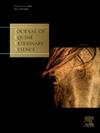The relationship between post-thaw sperm quality and blastocyst production following Intracytoplasmic Sperm Injection (ICSI) of in vitro-matured equine oocytes
IF 1.3
3区 农林科学
Q2 VETERINARY SCIENCES
引用次数: 0
Abstract
In vitro production of equine embryos by Intracytoplasmic Sperm Injection (ICSI) is commonly utilized to maximize the availability of sperm from stallions with limited semen supply. The relationship between standard measures of sperm quality in frozen/thawed semen (i.e., sperm motility, normal morphology, DNA quality) and embryo production after ICSI of in vitro-matured equine oocytes has not been thoroughly studied. In this study, frozen/thawed semen from 44 stallions utilized in a commercial ICSI program was analyzed for post-thaw total and progressive motility (determined both subjectively and by Computer-Assisted Sperm Analysis [CASA]), morphology features (Differential Interference Contrast [DIC] microscopy), and DNA damage (Sperm Chromatin Structure Assay – SCSA) before and after sperm selection by swim-up. Sperm selected by swim-up were used for Piezo-driven ICSI on 485 in vitro-matured equine oocytes obtained by transvaginal oocyte aspiration (TVA) from 59 mares (85 cycles). The relationship between sperm quality characteristics (before and after swim-up), cleavage (>8 blastomeres at day five [5] post-ICSI), and blastocyst rates (day 7 to 10 post-ICSI) was studied using a stepwise logistic regression model (JMP Pro 17.0; SAS Institute, Cary, NC). Statistical significance was set at P<0.05. Data are presented as mean ± SD. Descriptive parameters of ICSI efficiency in this commercial program included: in vitro oocyte maturation rate: 64 ± 18%; cleavage rate at day 5: 62 ± 22%; blastocyst rate per injected oocyte: 29 ± 25%; blastocyst rate per cleaved oocyte: 46 ± 12%; number of blastocysts produced: 139; blastocyst per TVA/ICSI session: 1.64. No single sperm quality parameter was associated with cleavage rate. Post-thaw sperm quality parameters associated with a positive ICSI outcome (i.e., blastocyst production after TVA/ICSI cycle) included mean total motility before swim-up, determined subjectively (33 ± 14%; odds ratio [OR]: 1.20, 95% confidence interval [CI]: 1.02 – 1.42) or by CASA (26 ± 13%; OR: 1.08, CI: 1.01 – 1.28), and morphologically normal sperm (57 ± 12%; OR: 1.31, CI: 1.10 – 1.57). In contrast, mean ± SD proximal droplets after swim-up (3 ± 2 %; OR: 0.63, CI: 0.41 – 0.94), coiled tails before swim-up (4 ± 1%; OR: 0.25, CI: 0.08 – 0.63), and COMPαt before swim-up (16 ± 8%; OR: 0.74, CI: 0.57 – 0.96) were associated with a negative ICSI outcome (i.e., no blastocyst production after a TVA/ICSI cycle). The current study provides clinically useful data regarding post-thaw sperm quality measures that can be assessed in any laboratory setting to determine the fertility potential of frozen/thawed stallion sperm for ICSI.
求助全文
约1分钟内获得全文
求助全文
来源期刊

Journal of Equine Veterinary Science
农林科学-兽医学
CiteScore
2.70
自引率
7.70%
发文量
249
审稿时长
77 days
期刊介绍:
Journal of Equine Veterinary Science (JEVS) is an international publication designed for the practicing equine veterinarian, equine researcher, and other equine health care specialist. Published monthly, each issue of JEVS includes original research, reviews, case reports, short communications, and clinical techniques from leaders in the equine veterinary field, covering such topics as laminitis, reproduction, infectious disease, parasitology, behavior, podology, internal medicine, surgery and nutrition.
 求助内容:
求助内容: 应助结果提醒方式:
应助结果提醒方式:


